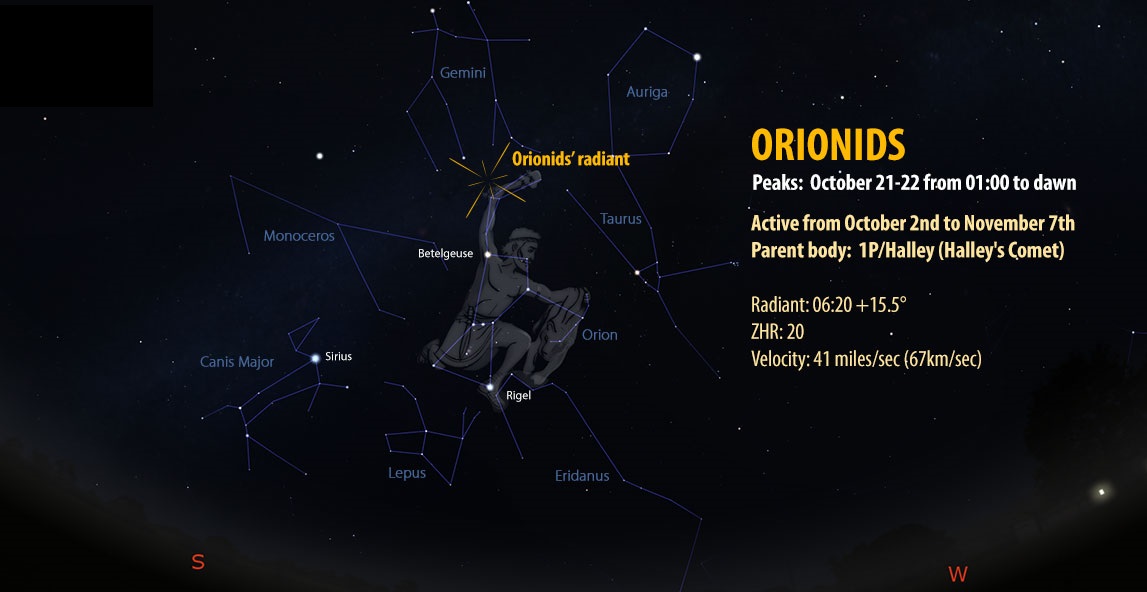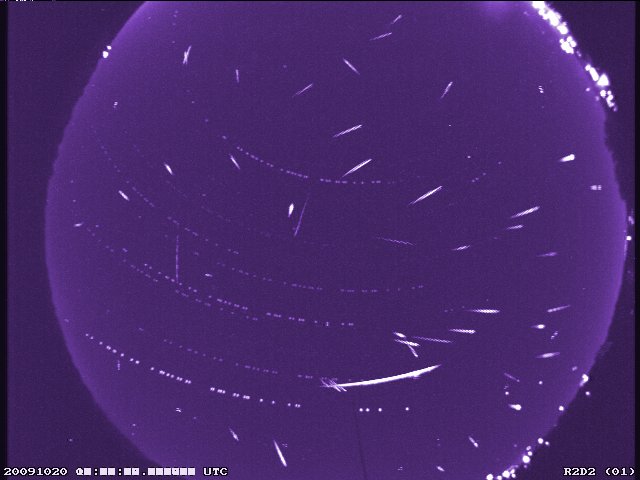Each October the Earth passes through the inbound debris of Halley’s Comet to produce the Orionid Meteor Shower. The outbound activity is seen in April and May of each year as the eta Aquariid meteor shower. Orionid activity is usually low until mid-October, when we pass closer to the core of these orbits. The Orionids are a medium strength shower, usually producing 15-20 showers members per hour at maximum as seen from dark sky locations. There have been surprises in the past when rates were three times this strong. Such strong activity is not expected this year, but only by observing this activity will we know for certain what occurs.
This illustration of debris from Halley’s Comet orbiting the sun is provided by Dr. Peter Jenniskens, SETI Institute/NASA/Ames Research Center.
This year the maximum activity is predicted to occur on the morning of October 22nd when up to 20 swift Orionid meteors could be visible per hour from rural locations away from city lights. Orionid meteors are not visible until after 22:00 (10pm) local daylight saving time as the source of these meteors does not rise above the eastern horizon until then. The best time to see these meteors is from 01:00 to dawn, when the Orionid radiant lies in excess of 30 degrees above the horizon. At the time of maximum activity the source of these meteors lies just east of the faint club of Orion. This position also lies about 10 degrees northeast of the bright orange star known as Betelgeuse (alpha Orionis). 10 degrees is equal to one’s fist with your arm held straight out.

The bright moon often interferes with viewing meteor activity by obscuring the fainter meteors. Lunar conditions are favorable in 2023 as the first quarter moon (50% illuminated) will set near midnight on October 22nd. This will allow the more active morning to be completely free of interfering moonlight. With the moon out of the way the only things that would stop you from seeing the show would be clouds and bright city lights. There is not much can do about cloud cover other than checking at later times during the morning. If the entire night is lost to clouds you can try again on the next night as Orionid activity will be almost as strong on the night of October 22/23. In fact the Orionids are strong for several night surrounding October 22nd, so if the night of maximum is predicted to be cloudy, you can still witness good rates just before and after the maximum. As for bright city lights, it is highly recommended that you find a safe rural observing spot away from city lights as the more stars you can see, the more meteors you will count.
The best way to see these meteors is to lie in a comfortable lounge chair with the back angled so that you are looking about half-way up in the sky. You can look straight up if your sky near the horizon is brightly lit, but more meteors are seen in the lower half of the sky than straight up as you are looking through a much thicker column of the atmosphere. I would recommend facing due south so that you can also distinguish minor meteor activity that is coming from Taurus, Gemini, and Leo Minor. Taurid meteors would be slower than the Orionids while those from Gemini and Leo Minor would also be swift, like the Orionids. These minor showers usually only produce about 2 meteors per hour at best. There are also random meteors that do not belong to any recognizable source. On October mornings these random meteors normally usually number about 10 per hour. It should be mentioned that the Orionids and the other minor showers are all visible from the Southern Hemisphere, but at lower elevations in their northern sky.

Viewing meteor activity is a great way to easily contribute to science by being a citizen scientist. In order to produce scientifically useful data you need to view for at least one hour and provide shower associations with each meteor you witness. It also is necessary to provide us with the magnitude of the faintest star you can see. This is easily done by counting the number of stars visible with certain areas of the sky – see also https://www.imo.net/observations/methods/visual-observation/ and here for more tips on viewing meteor showers. In order to share your observations it is suggest that you to fill out a visual meteor report form from the International Meteor Organization. This is only available to registered members, but this option is free to those who just wish to contribute data. We strongly encourage everyone to join the IMO as a full member as detailed analysis of the Orionids and others meteors showers is presented in the IMO Journal.
We wish you good luck and look forward to seeing your viewing resul




 You saw something bright and fast? Like a huge shooting star? Report it: it may be a fireball.
You saw something bright and fast? Like a huge shooting star? Report it: it may be a fireball.  You counted meteors last night? Share your results with us!
You counted meteors last night? Share your results with us!  You took a photo of a meteor or fireball? You have a screenshot of your cam? Share it with us!
You took a photo of a meteor or fireball? You have a screenshot of your cam? Share it with us!  You caught a meteor or fireball on video? Share your video with us!
You caught a meteor or fireball on video? Share your video with us!
2 comments
I enjoyed Robert Lunsford’s article on the Orionids meteor Shower. I will have to look up Mr Lunsford’s book on meteors. I saw a very interesting fireball in the late 1970’s while hunting forbearers late at night. The fireball may have been a close call from a sizable object, I would have to describe the sighting to an expert to know. I have seen five other notable fireballs including one that was visible in Hershey PA during the daytime and impacted in northern PA. The “interesting fireball” and the daylight occurrence of one left lasting for a lifetime impressions. I never had much luck hunting foxes and things back then, but the stars were beautiful as was the moon rising over Blue Mountain. We were in Saint Anthony’s Wilderness, the largest roadless expanse in Pennsylvania and probably was and probably still is the darkest sky area anywhere near my home. Due to light pollution and I suppose atmospheric pollution the stars are not nearly as visible in my rural location near Hershey PA as they were when I was a young man.